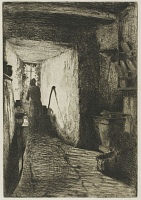Etchings Institutions search term: grolier club
The Kitchen | ||
| Number: | 16 | |
| Date: | 1858 | |
| Medium: | etching | |
| Size: | 227 x 157 mm | |
| Signed: | 'Whistler' at lower right | |
| Inscribed: | 'Imp. Delatre. Rue St. Jacques. 171.' at lower right (2); partly removed (3) | |
| Set/Publication: | 'French Set', 1858; Fine Art Society, 1885 (3) | |
| No. of States: | 3 | |
| Known impressions: | 67 | |
| Catalogues: | K.24; M.24; T.13; W.19 | |
| Impressions taken from this plate (67) | ||
TECHNIQUE
This etching is based closely on a sketch in pencil and watercolour, The Kitchen
[m0235], reproduced above. This suggests that it was actually etched back in the studio, possibly on Whistler's return to Paris. It is pure etching, with no drypoint.
PRINTING
No impression of the first state has been located: most are in the second state, of which some three dozen have been identified. It was printed by Auguste Delâtre (1822-1907) for the 'French Set' in 1858. Typical impressions of the etching in its second state printed by Delâtre are in dark brown ink on off-white chine appliqué ( ) and in black ink on ivory chine (
) and in black ink on ivory chine ( ,
,  ). Some however are in dark brown ink on ivory laid paper (i.e.
). Some however are in dark brown ink on ivory laid paper (i.e.  ). The area around the window was usually wiped cleaner than the rest, while the shadows gain extra depth from slightly darker tone on the surface.
). The area around the window was usually wiped cleaner than the rest, while the shadows gain extra depth from slightly darker tone on the surface.
 ) and in black ink on ivory chine (
) and in black ink on ivory chine ( ,
,  ). Some however are in dark brown ink on ivory laid paper (i.e.
). Some however are in dark brown ink on ivory laid paper (i.e.  ). The area around the window was usually wiped cleaner than the rest, while the shadows gain extra depth from slightly darker tone on the surface.
). The area around the window was usually wiped cleaner than the rest, while the shadows gain extra depth from slightly darker tone on the surface.Ten impressions of the etching as published in the third state by the Fine Art Society, London, have been located. These impressions were printed by Whistler, or under his supervision. In March 1884 Marcus Bourne Huish (1843-1904) was asking Whistler for 'a few proofs', and on 12 June the F.A.S. acknowledged receipt of fifty proofs and a proof of the cancelled plate. 11
According to Kennedy, 'Fifty impressions of this [3rd] state were printed by Whistler, who then trimmed off the margins, except the part signed in pencil with the butterfly and "imp." The plate was then cancelled. Published by The Fine Art Society, in 1885.' 12 Nothing like the number of impressions indicated by Kennedy have been located; presumably there are a lot hidden in dark corners.
12: Kennedy 1910 (cat. no. 24).
A typical example of the Fine Art Society edition was printed in dark brown ink with surface tone wiped to emphasize the light area near the window; it shows distinct signs of wear around the figure ( ). It is trimmed to the platemark and signed with a butterfly 'imp' on the tab, which can be dated to 1885.
). It is trimmed to the platemark and signed with a butterfly 'imp' on the tab, which can be dated to 1885.
 ). It is trimmed to the platemark and signed with a butterfly 'imp' on the tab, which can be dated to 1885.
). It is trimmed to the platemark and signed with a butterfly 'imp' on the tab, which can be dated to 1885.

